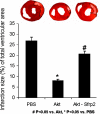Secreted frizzled related protein 2 (Sfrp2) is the key Akt-mesenchymal stem cell-released paracrine factor mediating myocardial survival and repair
- PMID: 17251350
- PMCID: PMC1785280
- DOI: 10.1073/pnas.0610024104
Secreted frizzled related protein 2 (Sfrp2) is the key Akt-mesenchymal stem cell-released paracrine factor mediating myocardial survival and repair
Abstract
Stem cell therapy has emerged as a promising tool for the treatment of a variety of diseases. Previously, we have shown that Akt-modified mesenchymal stem cells mediate tissue repair through paracrine mechanisms. Using a comprehensive functional genomic strategy, we show that secreted frizzled related protein 2 (Sfrp2) is the key stem cell paracrine factor that mediates myocardial survival and repair after ischemic injury. Sfrp2 is known to modulate Wnt signaling, and we demonstrate that cardiomyocytes treated with secreted frizzled related protein increase cellular beta-catenin and up-regulate expression of antiapoptotic genes. These findings reveal the key role played by Sfrp2 in mediating the paracrine effects of Akt-mesenchymal stem cells on tissue repair and identify modulation of Wnt signaling as a therapeutic target for heart disease.
Conflict of interest statement
The authors declare no conflict of interest.
Figures






References
-
- Caplice NM, Deb A. Nat Clin Pract Cardiovasc Med. 2004;1:90–95. - PubMed
-
- Melo LG, Pachori AS, Kong D, Gnecchi M, Wang K, Pratt RE, Dzau VJ. Circulation. 2004;109:2386–2393. - PubMed
-
- Beltrami AP, Barlucchi L, Torella D, Baker M, Limana F, Chimenti S, Kasahara H, Rota M, Musso E, Urbanek K. Cell. 2003;114:763–776. - PubMed
-
- Alvarez-Dolado M, Pardal R, Garcia-Verdugo JM, Fike JR, Lee HO, Pfeffer K, Lois C, Morrison SJ, Alvarez-Buylla A. Nature. 2003;425:968–973. - PubMed
Publication types
MeSH terms
Substances
LinkOut - more resources
Full Text Sources
Other Literature Sources
Medical
Molecular Biology Databases

